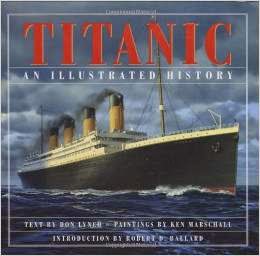Titanic's tragedy was a world-wide event. Although almost half of the souls on her board were either American or British, the rest came from every corner of the globe. Citizens from every inhabited continent set sail in Titanic and when she went down families in twenty-seven countries lost loved ones. (Japan's sole passenger, Masabumi Hosono, survived the wreck but was ostracized ever after because he did not die). People of all faiths, walks of life and backgrounds went to sea, trusting their lives to this fabled ship that was supposed to be the acme of beauty and technology. When she sank, travel regulations around the world changed as well.
After Titanic, every vessel maintained radio operations, 24 hours a day. Too much can go wrong when communications are shut down. Afterwards, lifeboats were apportioned by the number of souls on board instead of the ship's displacement weight and drills became part of each voyage. When I went on a cruise a few years ago, they gathered us for a life boat drill before we had reached the open ocean. I watched the holiday makers in their vacation shirts and shorts looking for their boat line assignments and knew this was because of Titanic. Never again would passengers and crew set sail ignorant of where to go in case of a disaster. It was a terrible lesson, but we learned.
For my money, the best book on Titanic (and there have been hundreds) is still Walter Lord's A Night to Remember. In simple, plain language Lord recounts the tragedy, capturing the phrases that haunted survivors' memories. Guggenheim's "We've dressed up in our best and are prepared to go down like gentlemen."; Ida Straus's refusal to desert her husband and take to a lifeboat saying, "Where you go, I will go." There is the unknown porter saying, "There's talk of an iceberg, madam." and the assertion that,"God, himself could not sink this ship." It's a masterpiece of reporting and for many, the first, best account of what happened on that incredible night. No film with fictional characters can surpass this retelling of what actually happened. The only drawback to Lord's book is that it was written long before the wreck was discovered and that is a story to be reckoned with.
In the seventy years between her sinking and discovery, a great many theories about Titanic were proposed. Only a handful of the survivors insisted that the ship broke before she completely submerged and their words were largely discounted. People preferred to hope that Titanic was still intact and recoverable somewhere on the ocean's floor or suspended between layers of water, gliding on an endless voyage with her dead. Bob Ballard's discovery finally put the theories to rest and earned him a spot in the history as well as changing the focus of his own life (despite his other accomplishments, Ballard will always be recognized first as the man who found the Titanic). His accomplishment, along with the story of the sinking is captured beautifully in Titanic: An Illustrated History. Here is the story of Titanic's discovery, introduced by Mr. Ballard, along with a series of photos and illustrations that help the ordinary reader grasp the beauty of the liner during her short life and what was discovered by Ballard and his team. It's a fascinating resource and the illustrations of Ken Marschall are beautiful and moving if sometimes terrible to look at. Without gore or extra artifice, he brings the horror of that night home.
Perhaps the true measure of history is when it continues to touch people long after the world has moved on. If so, I hope people remember the achievement and joy that must have been part of Jackie Robinson's April 15th. It was another step in a good march that the country need to take. Mr. Robinson made the 15th of April a good day. It just came after a long, cold night.


No comments:
Post a Comment